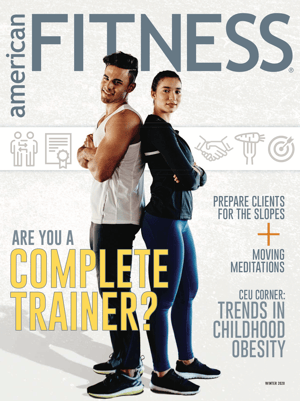Originally published in the Winter 2020 issue of American Fitness Magazine.
The four words every client loves to hear: “It’s time for cardio!” (Cue the collective eye roll from clients around the globe.) As personal trainers, we know that cardiovascular training is undoubtedly an important part of our clients’ overall health and ability to function in activities of daily living.
 However, finding the right workouts for particular clients means considering more than the physical benefits. It also means making sure that, whether we recommend traditional cardio equipment, like treadmills, bikes and rowers, or suggest HIIT classes with kettlebells, battle ropes and punching bags, we pick something our clients will enjoy, while minimizing their risk of injury.
However, finding the right workouts for particular clients means considering more than the physical benefits. It also means making sure that, whether we recommend traditional cardio equipment, like treadmills, bikes and rowers, or suggest HIIT classes with kettlebells, battle ropes and punching bags, we pick something our clients will enjoy, while minimizing their risk of injury.
Fortunately, NASM’s OPT™ model gives us a framework for looking at all of the factors that influence a client’s cardio success and enjoyment: Frequency, Intensity, Time, Type and Enjoyment—or FITTE.
5 FITTE FACTORS OF EFFECTIVE CARDIO PROGRAMS
Keeping in mind all of the following factors will help you integrate a client’s needs, goals and interests into your programming:
FREQUENCY
Frequency describes how often the client performs cardio. Lower-intensity cardio workouts can be performed more frequently, while higher-intensity cardio may require fewer sessions during the week with more rest between them, to avoid the risk of overtraining.
According to NASM Essentials of Personal Fitness Training (Jones & Bartlett Learning 2018), for general health, cardio should occur daily for short amounts of time, and for fitness gains, it should happen 3–5 days per week at higher intensities. Start beginner clients slowly by having them perform 1–3 days of cardio a week. See how quickly they recover, and then slowly add more days as fitness levels improve.
INTENSITY
Intensity describes how hard the client is working during the cardio workout. As a general rule of thumb, the more intense the workout is, the more recovery the client will need before the next session.
Looking at the client’s overall program in the scope of a week can help you identify days when you can increase intensity and days when the client will need more rest. Heart rate reserve, maximal heart rate, rating of perceived exertion and the talk test are a few methods of gauging intensity during workouts (NASM 2018).
TIME
Time describes how long the client spends doing cardio. For substantial health benefits, the 2018 Physical Activity Guidelines for Americans recommend that adults perform at least 150–300 minutes of moderate-intensity or 75–150 minutes of vigorous-intensity aerobic physical activity, or some combination of the two, each week (HHS 2018).
Client schedules will be the largest limiting factor when it comes to performing cardio. It’s efficient to have clients perform cardio on their own, with your programming guidance, but sometimes they can’t (or won’t) do that. If this is the case, you will need to find ways to work cardio into one-on-one sessions to ensure that your clients reap all the benefits of a balanced fitness program.
TYPE
Type describes the mode of exercise or specific equipment used to perform cardio. Cardio can be inclusive of any activity as long as the client’s exertion level is within the proper zone of training.
If the client has a specific cardio goal (such as running a marathon), this may guide your choice of modality. However, if the goal is simply to improve cardiovascular fitness, you can employ a variety of modalities to keep things fresh.
Including speed, agility and quickness (SAQ) and plyometric training (aka “reactive training”)—both of which are optional components of the NASM OPT model—is a great way to increase heart rate during a session without having to use more traditional cardio methods. Choose cardio exercises that will reinforce proper movement patterns, and be sure to keep in mind the client’s assessment results. Also, follow the NASM OPT model’s guidelines for phase and stage training to avoid increasing risk of injury by progressing too quickly.
ENJOYMENT
Enjoyment, of course, refers to how much the client likes the activity. Some clients will have favorite types of cardio, while others will tell you they avoid it like the plague.
One of the best ways to build a comprehensive, client-centered program is to begin with the ending in mind. That is, if you know clients who ultimately want to do the HIIT workout they saw in the latest fitness magazine, you can help them work toward that goal by starting them out at a cardio training level that’s appropriate for their current fitness level and then progress from there. Allowing your clients to have input in their cardio programming will increase the likelihood that you’ll choose something they enjoy—or as close to it as you can get. If your clients enjoy what they’re doing, they’re likely to continue to do it! It’s a win-win for everyone.
A CLOSER LOOK AT INTENSITY: IS YOUR CLIENT IN THE ZONE?
How do you know whether your client’s cardio is at the intensity you intend? If your client is wearing a heart rate monitor, you can quickly gauge their zone using maximal heart rate. (HRmax is easy for clients to remember, because it’s simply 220 minus the client’s age. Multiplying by 0.65, then, gives you the heart rate that is 65% of the client’s HRmax.)
Of course, there are also two easier ways (no equipment, no math) to gauge a client’s effort during cardio sessions: rating of perceived exertion and the talk test.
To determine RPE, ask clients how hard they feel they are working (hard, very hard, not very hard at all, etc.). For the talk test, simply engage them in conversation during cardio to see how many words they can speak between breaths.
Here are how the three methods relate to one another:
Zone 1 (65%–75% of HRmax) equals an RPE of “moderate” to “somewhat hard.” The client may need to take a few breaths between sentences.
Zone 2 (76%–85% of HRmax) equals an RPE of “hard” to “very hard.” The client is able to say only three or four words between breaths.
Zone 3 (86%–95% of HRmax) equals an RPE of “very hard” (but not maximal effort). Though the client is still able to speak, he or she can say only one or two words between breaths.
If your clients are doing their cardio on their own (that is, between sessions with you), be sure to guide them on the use of one or more of the above methods, what to aim for in their solo workouts and how to adjust intensity up or down when needed.
A CLOSER LOOK AT TIMING: WHEN SHOULD CLIENTS DO CARDIO?
For clients who are not open to doing cardio on their own, there are a number of ways to integrate it into their one-on-one sessions with you—before, during or after resistance training. Let’s explore some of the pros and cons of these options.
CARDIO BEFORE OR AFTER RESISTANCE TRAINING
Beginning or ending a session with cardio is a common practice among personal trainers.
Pros: Some clients may enjoy a cardio burst at the beginning or end of the workout—they may feel it pushes their limits and gives them that sweat they’re after. If you work in a big-box gym, spending a dedicated amount of time on a cardio machine and then moving to the resistance training area is much easier than doing circuit training (hopping back and forth between cardio equipment and resistance equipment throughout the session).
Cons: Performing cardio at the beginning or end of a session will mean less time performing resistance training, since overall training time is limited. One way around this is to complete the 60-minute session with your clients, then ask them to finish (on their own) immediately afterward with 10 minutes on the treadmill or rowing machine, for example. (Of course, you can also flip this and ask them to do a 10-minute cardio warmup on their own right before your training session.)
CARDIO DURING RESISTANCE TRAINING
One way to integrate cardio is with circuits, where resistance exercises are performed back to back with little to no rest. Circuit training minimizes rest time between exercises to keep heart rate elevated during the training session—thus providing a cardio component.
Pros: This is an incredibly efficient way to train. Circuit training is also helpful for clients who don’t enjoy traditional cardio, such as jogging, rowing or cycling.
Cons: Circuits can be tricky in busy big-box gyms, particularly if you plan to use multiple pieces of equipment. However, it can be done with some good planning! One workaround is to think of the circuit in terms of supersets, which alternate between just two moves and, thus, two types of equipment. Or you can plan a circuit workout that uses mostly body-weight and free-weight exercises. These approaches minimize or eliminate the potential problem of having to wait for a machine.
PUTTING IT ALL TOGETHER WITH NASM STAGES AND PHASES
NASM recommends the use of stage training to systematically progress a client’s cardiovascular training. See below for an overview of stage training and a sample “Active-Recovery Day” workout that clients can do on their own. If you prefer to integrate the cardio into your one-on-one session, you can simply progress the activity in the same way you do with resistance training, using the NASM OPT model’s five phases.
SAMPLE “ACTIVE-RECOVERY DAY” CARDIO WORKOUT
This chart provides suggestions to help program an effective cardio workout for clients to do as active recovery on their “off” days. (Of course, clients can also schedule a cardio workout to do in your presence so you can check their form and help them understand how to track and adjust their intensity.) Ask clients to keep a log of their solo cardio workouts to share with you during your weekly resistance training sessions.
PROGRESSING CARDIO USING THE NASM OPT MODEL’S 5 PHASES
To simplify programming for clients who are combining cardio with their resistance training workout, it may be helpful to progress both types of training using the NASM OPT model.
Here is an example of how you might achieve this:
PROGRAMMING FOR FITTE-NESS IS WORTH THE EFFORT
Cardiovascular training is vital to helping your clients achieve optimal overall health and reach their fitness-related goals. When properly integrated into the workout, cardio training can help clients maximize calorie burn and have a good time. Using the FITTE principle alongside NASM OPT stage and phase training can help them achieve all of this safely and efficiently while getting the most bang for their buck.
Read more for a different perspective on cardio: Metabolic Conditioning Moving Beyond Cardio
REFERENCES
HHS (U.S. Department of Health and Human Services). 2018. Physical Activity Guidelines for Americans (2nd ed.). Accessed Sep. 7, 2019: health.gov/paguidelines/second-edition/pdf/Physical_Activity_Guidelines_2nd_edition.pdf.
NASM (National Academy of Sports Medicine). 2018. NASM Essentials of Personal Fitness Training (6th ed.). Burlington, MA: Jones & Bartlett Learning, 208–14.

















